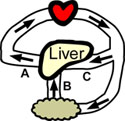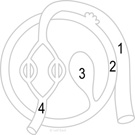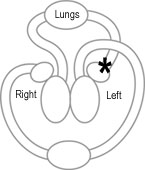IPHY 3410
Instructor: Dr. Leif Saul
Fall 2023

IPHY 3410Instructor: Dr. Leif Saul
|
 |
NOTE: these questions are intended for practice only. They do not reflect all major topics covered in the lectures. Also, the proportion of questions on each topic may not match the distribution of content that was presented and the allocation of questions on the actual exam.
1. Arteries between 0.01 and 0.3 mm in diameter are known as
A. Arterioles
B. Muscular arteries
C. Venules
D. Capillaries
E. Elastic arteries
2. Which of the following would you expect to find within ganglia?
A. Microglia
B. Oligodendrocytes
C. Satellite cells
D. Astrocytes
E. Ependymal cells
3. In premature babies, respiratory distress syndrome occurs because
A. There are not enough alveoli in the lungs
B. Surface tension makes it difficult to expand the lungs
C. Type I cells are immature and do not produce enough surfactant
D. Type II cells are immature and produce too much surfactant
E. The bronchioles are too narrow
4. During inspiration,
A. The diaphragm lifts up to increase the volume of the thorax
B. The pressure inside the pleural cavity increases
C. The pressure inside the lungs decreases
D. B and C
E. All of the above
5. Each tertiary bronchus
A. Splits into two secondary bronchi
B. Serves one lobe of the lung
C. Serves one alveolus
D. Serves two or three lobes, depending on the lung
E. None of the above
6. Which of the following represents a possible path that blood may follow as it moves ONCE through the systemic circuit? (Some steps may be omitted.)
(1) Heart, (2) Capillaries, (3) Arteries, (4) Veins
A. 3 --> 4 --> 2 --> 4 --> 1
B. 1 --> 3 --> 4 --> 2 --> 3
C. 3 --> 2 --> 3 --> 2 --> 4
D. 1 --> 4 --> 2 --> 3 --> 1
E. 2 --> 3 --> 2 --> 4 --> 1
7. Internal respiration occurs
A. In the myocardium layer of the heart wall
B. In the systemic circuit
C. In the pulmonary circuit
D. A and B
E. All of the above
8. How many layers of serous pericardium lie between the inside of the heart and the outside of the body?
A. 0
B. 1
C. 2
D. 3
E. 4
9. The pulmonary trunk
A. Is a vein carrying deoxygenated blood
B. Is an artery carrying deoxygenated blood
C. Is a vein carrying oxygenated blood
D. Is an artery carrying oxygenated blood
E. Alternates between carrying oxygenated and deoxygenated blood
10. Blood flows through the mitral valve to enter the
A. Aorta
B. Pulmonary trunk
C. Right ventricle
D. Left ventricle
E. Right atrium
11. The second sound (the "dup" in "lub-dup") of each heart beat results when
A. The squeezing down of the ventricles pushes blood against the walls of the heart
B. Blood rushes into the ventricles to fill the vacuum produced after contraction
C. The elastic arteries recoil, causing valves to close
D. The chordae tendineae are suddenly pulled tight by the closing valves
E. Blood rushing out through the arteries vibrates the artery walls
12. Which of the following provides an electrical pathway through which the heart contraction signal spreads from one part of the heart to another?
A. Gap junctions
B. Neurons
C. Tight junctions
D. A and B
E. All of the above
13. Damage to the AV node or the Bundle of His
A. Prevents the entire heart from contracting
B. Prevents only the ventricles from contracting
C. Prevents only the atria from contracting
D. Causes the ventricles to contract faster than normal
E. Causes the ventricles to contract slower than normal
14. All blood vessels (arteries, veins, and capillaries) have:
A. Simple squamous epithelium
B. Endothelium
C. Tunica intima
D. B and C
E. All of the above
15. Most named arteries
A. Are muscular arteries
B. Are elastic arteries
C. Are arterioles
D. Lack a tunica externa
E. Lack a tunica intima
16. In a typical capillary bed, what happens when the surrounding tissue is active and requires a lot of oxygen?
A. Arterioles dilate
B. Arterioles constrict
C. Precapillary sphincters dilate
D. Precapillary sphincters constrict
E. Venules constrict
n17. Sinusoid capillaries occur in the
A. Kidney
B. Skin
C. Lungs
D. Spleen
E. Muscles
18. About two-thirds of the blood in the body is contained in the
A. Capillaries
B. Veins
C. Arteries
D. Heart
E. Lungs
19. The sympathetic nervous system
A. Contains afferent neurons
B. Is the somatic motor division of the nervous system
C. Is the visceral sensory division of the nervous system
D. Includes both somatic motor and visceral sensory neurons
E. None of the above
20. Nodes of Ranvier are found in or on what structure?
A. Dendrite
B. Axon
C. Cell body
D. Synaptic cleft
E. Stem cells
21. What cell in the brain destroys dead cells and pathogens?
A. Microglia
B. Ependymal cells
C. Schwann cells
D. Oligodendrocyte
E. Astrocytes
22. Myelin
A. In the CNS is formed from oligodendrocytes
B. In the PNS is formed from Schwann cells
C. Increases the speed of electrical impulses
D. B and C
E. All of the above
23. The diagram, showing the blood circulation among the heart (at top), liver, and small intestine, is similar to the one shown in class except it omits all other organs. Which vessel represents the hepatic vein? |
 |
24. A nerve fiber
A. Is connective tissue at the core of every nerve
B. Is also known as a neuron
C. Is a group of blood vessels accompanying a fascicle
D. Is found only in some nerves
E. None of the above
25. Lymphatic capillaries
A. Have a wall consisting of endothelium only
B. Have minivalves
C. Carry fluid in one direction only
D. B and C
E. A, B, and C
26. The primary brain vesicle that gives rise to the cerebellum is the
A. Metencephalon
B. Rhombencephalon
C. Myelencephalon
D. Mesencephalon
E. Diencephalon
27. Cerebrospinal fluid enters the fourth ventricle directly from which of the following structures or spaces?
A. The cerebral aqueduct
B. The choroid plexus in the fourth ventricle
C. The subarachnoid space
D. A and B
E. A and C
28. In the liver, the portal arterioles
A. Are branches of the hepatic portal vein
B. Are branches of the common hepatic duct
C. Are branches of the central vein
D. Are branches of the hepatic vein
E. None of the above
29. Which of the following is true of all leukocytes?
A. They spend most of their time in the blood
B. They attack only specific antigens
C. They attack any antigen that is non-self
D. They are restricted to the lymphatic system
E. None of the above
30. The thymus
A. Pumps lymph
B. Breaks down red blood cells
C. Is for the maturation of lymphocytes
D. Controls metabolic rate throughout the body
E. Is adjacent to the stomach
31. The respiratory zone of the lung consists of
A. Alveoli only
B. Alveoli and terminal bronchioles
C. Alveoli and respiratory bronchioles
D. Alveoli, terminal bronchioles, and respiratory bronchioles
E. Alveoli, terminal bronchioles, respiratory bronchioles, and small bronchi
32. In the diagram at right, region 2 contains ___ which flows into region ___. |
 |
33. In the diagram above, the fluid leaving region 4 will first enter what chamber of the heart?
A. Left atrium
B. Left ventricle
C. Right atrium
D. Right ventricle
E. [Not an option]
34. Which of the following has an epithelial lining that is ciliated?
A. Oropharynx
B. Inferior larynx
C. Laryngopharynx
D. A and B
E. A and C
35. Place the following structures in correct order for air passing into the lungs:
(1) Cricoid cartilage, (2) nasal cavity, (3) rima glottidis, (4) laryngopharynx, (5) external nares
A. (1) --> (2) --> (5) --> (4) --> (3)
B. (1) --> (5) --> (2) --> (3) --> (4)
C. (5) --> (4) --> (2) --> (1) --> (3)
D. (3) -->(5) --> (2) --> (4) --> (1)
E. (5) --> (2) --> (4) --> (3) --> (1)
36. What is/are found (at least partly) in the mediastinum?
A. Primary bronchi
B. Chordae tendineae
C. Trachea
D. A and C
E. All of the above
37. The pancreas contains
A. Exocrine cells that secrete glucagon
B. Endocrine cells that secrete enzymes
C. Exocrine cells that secrete bicarbonate
D. Exocrine cells that secrete insulin
E. Endocrine cells that secrete mucus
38. Oxygen diffuses from blood into cells. This process is known as
A. Internal respiration
B. External respiration
C. Cellular respiration
D. Ventilation
E. Inspiration
39. To make a high-pitched sound, you would normally:
A. Close the vestibular folds
B. Apply tension to the vocal folds
C. Close the rima glottidis
D. Lower the cricoid cartilage
E. Lower the epiglottis
40. Which of the following is made of elastic cartilage?
A. Thyroid cartilage
B. Cricoid cartilage
C. Arytenoid cartilage
D. Epiglottis
E. All of the above
41. In the diagram at right, what heart valve is indicated by the asterisk? |
 |
42. In the diagram above, blood flows directly from the ___ to the asterisk.
A. Left atrium
B. Pulmonary veins
C. Pulmonary arteries
D. Pulmonary trunk
E. Superior vena cava
43. Blood is normally found inside which of the following?
A. Lumen of duodenum
B. Hepatocytes
C. Bile duct
D. All of the above
E. None of the above
44. In the liver, canaliculi are
A. Spaces between adjacent hepatocytes
B. Passageways for the transport of bile
C. Passageways for the transport of blood
D. A and B
E. B and C
45. Blood in the hepatic portal vein
A. Comes directly from the heart
B. Has just finished being processed by the liver
C. Has high levels of nutrients after a meal
D. Has a high level of oxygen
E. Carries bile out of the liver
46. Which of the following transports blood away from the liver?
A. Hepatic vein
B. Hepatic portal vein
C. Hepatic artery
D. A and B
E. All of the above
47. A drop of blood travels only once through the pulmonary circuit, and only once through the systemic circuit, in either order. Which of the following lists structures that it will pass through, in the correct sequence? (Many steps are omitted.)
A. Pulmonary vein -> hepatic portal vein -> aorta -> capillary
B. Coronary sinus -> tricuspid valve -> mitral valve -> dural sinus
C. Left ventricle -> central vein -> left atrium -> hepatic artery
D. Coronary artery -> hepatic vein -> pulmonary trunk -> venule
E. Pulmonary semilunar valve -> left ventricle -> portal arteriole -> inferior vena cava
ANSWERS
1. A
2. C
3. B
4. C
5. E
6. A
7. D
8. C
9. B
10. D
11. C
12. A
13. E
14. E
15. A
16. A
17. D
18. B
19. E
20. B
21. A
22. E
23. A
24. E
25. E
26. B
27. D
28. E
29. E
30. C
31. C
32. C
33. C
34. B
35. E
36. E
37. C
38. A
39. B
40. D
41. E
42. B
43. E
44. D
45. C
46. A
47. E